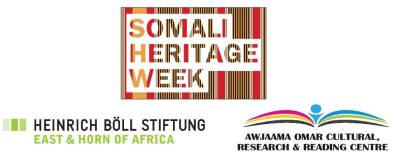Home » Uncategorized
Category Archives: Uncategorized
Somali Heritage Week 2015
November 2015 Somali community came together to celebrate their unique art and culture at the National Museum of Kenya. The Somali Heritage Week was organized to promote social cohesion, celebrating arts and culture and highlight the contributions that Somali people have made to the public sphere in Kenya with the theme “Identity: What Does It Mean To Be Somali Kenyan?” “ We wanted to tell the story of how the Somali people are an integral and inseparable part and parcel of this nation,”says Heinrich Boell Programme Coordinator, Nanjala Nyabola.
The event was attended by Somali intellectuals, students, elders, youth, academics, the government officials and other Kenyan communities. Awjaama Omar Executive Director, Fardowsa Jama said “We are nothing with out our culture and language.”
Although Somalis may differ in nuances of local lifestyle, they share a uniform language, religion, and culture, and trace their heritage to a common ancestor. Nearly 80% of the Somali people are pastoralists.
Somali Culture
The Somali Heritage Week celebrated;
- Somali Language
- The Somali calendar
- Fashion (Somali Fashion)
- Art, Poetry, and Somali traditional Song
- panel conversations
- The Somali kitchen
Somali Language
The Somali language is spoken in Somalia, Djibouti, the Somali regions of Ethiopia, and the northeastern region of Kenya. A panel discussion brought together Somali writers gave the audience an Introduction to Somali poetry. The Somali language has a long and rich tradition of proverbs and idioms, which are passed down through generations and embellished by the individual speaker. Everyday Somali speech often includes these expressions. (Putnam & Noor, 1999)
The Somali calendar
The community has its unique calendar based on both the solar and lunar calendric systems, and estimated to date back 2,500 years. It is organized into four seasons (Xagaa, Dayr, Dirac, Gu’,) twelve months, and 52 weeks plus one day or 365 days
| easons | Months | Days | Gregorian Date |
| Xagaa, 13 weeks: | Karan | 31 | July 20 |
| Habar-ari | 30 | August 20 | |
| Diracgood | 30 | September 19 | |
| Dayr, 13 weeks: | Dayrweyn | 31 | October 19 |
| Ximir | 30 | November 19 | |
| Xays | 30 | December 19 | |
| Dirac, 13 weeks: | Lixkor | 31 | January 18 |
| Toddob | 30 | February 18 | |
| Aminla | 30 | March 20 | |
| Gu’, 13 weeks + 1:’ | Fushade | 31 | April 19 |
| Gu’soore | 30 | May 20 | |
| Samuulad | 31 | June 19 |
Art, Poetry, and Somali traditional Song
Among the traditional dance are Dhaanto, balaqley, buraanbur, hees and many more.While the Somali handicraft was displayed at the museum Tawalk youth group and Gargaar women have been performing through out the week.
The 19th century English explorer Richard Burton famously described Somalis as a ‘nation of poets’ in his classic work First Footsteps in East Africa. Poetry has traditionally been the principal medium through which Somalis define their identity, record their history, express their innermost feelings and communicate their views.
By Rahma Mire
SOMALI HERITAGE WEEK
Somali Heritage Week, Nov. 18-21 2015 @ the National Museum of Kenya
Dates: Date: 18 to 21 November, 2015
Venue: National Museum of Kenya
Time: from 9 am
Entrance: Free for all audiences
Experience an exciting and informative program of talk, music, dance, art, storytelling and much more as we celebrate the contributions of the Somali people to the beauty and cultural richness of Kenya.
Featuring some of the best known thinkers, writers, performers and live entertainment stages, the Somali Heritage Week will showcase the best of Somali culture from Kenya and the region on the theme “Identity: What does it mean to be Somali in Kenya?” The goal of this event is to create a place where Somali people and lovers of culture can come together to celebrate the community, to engage with the challenges facing the community, to sustain traditions and to provide a learning opportunity for those outside the culture.
The central site for the Heritage Week is the National Museum of Kenya, Museum Hill in Nairobi, Kenya, although a parallel youth programme will happen in at Awjaama Omar in Eastleigh and at PAWA 254 in Milimani.
http://calendar.boell.de/en/event/somali-heritage-week
Background
The project assumes that sharing information is a critical way to build trust. While it might not address all the systematic issues that have complicated the Somali people’s situation in Kenya, it hopes to at least start the long process of changing perceptions by taking information directly to the Kenyan people.
The project proposes a Somali heritage week, a 4-day festival of art, culture, literature and informative events organized by various stakeholders on the different dimensions of Somali identity coordinated by the Heinrich Boell Foundation and their implementing partner, Awjama Omar Cultural Research and Reading Centre.
Concept
The event is conceptualized as a 4-day festival, featuring independently organized, funded and run events coordinated centrally by the Awjaama Omar Cultural Center in Eastleigh with the support of Heinrich Boell Foundation.
The idea is to use public spaces in Nairobi to offer intellectual and cultural events. Together, participants will be invited to engage with the complexities of Somali identities in East Africa, and to confront many presumptions that non- Somali Kenyans might have about Somali people. The target audience is Somalis of various national identities, Kenyan youth (school groups, university groups), and the general public.
Objectives
- To create a space where Somalis of different nationalities can celebrate their cultural heritage
- To facilitate peer-to-peer interactions between Somalis of various national identities and Kenyans of other ethnic identities.
- To bring non-conflict related dimensions of Somali identity into focus.





